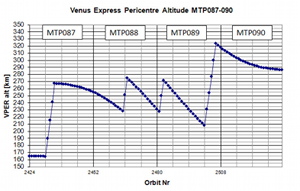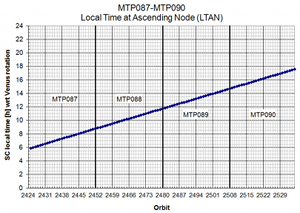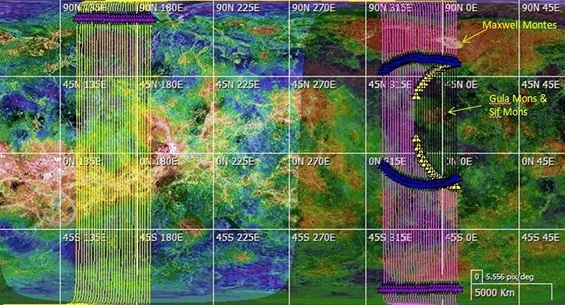No. 256 – Continuation of the fourteenth Earth occultation season, start of the twenty-third eclipse season, and start of surface imaging campaign
Cebreros ground station
All Cebreros ground station operations were nominal during this reporting period. Minor upgrades were implemented on the ground station radio frequency hardware and software. These upgrades were carried out without any interruption to station operations.
Regular maintenance of the ground station was scheduled on 8 and 9 January. Such maintenance activities and regular data downlinks from the spacecraft are carried out during the day in order to minimise operational costs. This means that the ground station is unavailable for part of the work day (from 11:30 to 16:00 local time) while maintenance activities are carried out. Thus, the time available for data downlinks from the spacecraft is reduced on days when ground station maintenance is performed.
Continuation of the fourteenth Earth occultation season
The fourteenth Earth occultation season continued throughout the planning period. Thirteen occultation measurements were performed during this time – these are listed in the 'Summary of main activities' table below.
For further information, please see Venus Express Earth Occultation Seasons – linked from the right-hand menu.
High accuracy spacecraft ranging
The New Norcia and Cebreros ground stations were used for a Delta Differential One-way Ranging (delta-DOR, or DDOR) measurement at the start of the Cebreros communications pass on 24 January. These measurements are carried out with the Venus Express spacecraft on a regular basis to support the accurate determination of the ephemeris for the planet Venus that is maintained by NASA's Solar System Dynamics Group.
For more information about DDOR, see the Delta-DOR measurements link in the right-hand column.
Orbit correction manoeuvres
Two orbit correction manoeuvres (OCMs) were planned during this period, on 20 and 21 January. Both were performed at apocentre, in order to raise the height of the orbit's pericentre. The manoeuvres were 'cool', meaning that during the OCM, the attitude of the spacecraft was such that no thermally sensitive faces were exposed to the Sun. The burns therefore did not heat up the spacecraft, and it was not necessary to provide for a subsequent cooling period. This meant that 'hot' science observations could be carried out after the manoeuvres, increasing the flexibility of the science operations.
 |
|
Change in Venus Express pericentre altitude during the period from 09 December 2012 to 30 March 2013. Credit: ESA |
The two OCMs had a planned magnitude of 1600 m/s each. They were prograde manoeuvres (the added impulse was in the direction of travel), designed to raise the pericentre altitude by 26 km and increase the orbital period by 42 s.
During the first manoeuvre, the burn underperformed by 0.43%, or 6.9 mm/s; the second underperformed by 0.21%, or 3.3 mm/s. The overall effect was that the pericentre altitude increase was within 165 m of the planned amount, and the orbital period increase was within 0.27 s of the value planned. This remarkable accuracy is typical of that achieved during OCMs.
Spacecraft clock synchronised
The clock on the Venus Express spacecraft is a simple count-up timer, typical of those used on spacecraft. These clocks save weight and cost but they tend to drift, and must be synchronised – or correlated – with atomic clocks on Earth at regular intervals. One of these regular time correlations was performed on 14 January after the Cebreros communication pass. A second one was performed on 30 January after the Cebreros communication pass.
Summary of main activities
The table below shows a chronology of the main spacecraft bus activities in the reporting period.
| Main activities during reporting period | |||
|
ADE = Atmospheric Drag Experiment; CEB = Cebreros; DOR = Differential One-way Ranging; DOY = Day of year; EOC = End of Charge; MET = Mission elapsed time; NNO = New Norcia; OCM = Orbit Correction Manoeuvre |
|||
|
MET (Day) |
Date | DOY | Main Activity |
| 2616 | 06-Jan-2013 | 006 | Occultation with NNO at pericentre. CEB communications pass. Downlink bitrate changed to 57 kbps. |
| 2617 | 07-Jan-2013 | 007 | Occultation with NNO at pericentre. CEB communications pass. |
| 2618 | 08-Jan-2013 | 008 | Occultation with NNO at pericentre. CEB communications pass. CEB maintenance 11:30 hrs to 16:00 hrs local time. |
| 2619 | 09-Jan-2013 | 009 | Occultation with NNO at pericentre. CEB communications pass. CEB maintenance 11:30 hrs to 16:00 hrs local time. |
| 2620 | 10-Jan-2013 | 010 | Occultation with NNO at pericentre. CEB communications pass. |
| 2621 | 11-Jan-2013 | 011 | CEB communications pass. |
| 2622 | 12-Jan-2013 | 012 | Occultation with NNO at pericentre. CEB communications pass. |
| 2623 | 13-Jan-2013 | 013 | CEB communications pass. |
| 2624 | 14-Jan-2013 | 014 | Occultation with NNO at pericentre. CEB communications pass. |
| 2625 | 15-Jan-2013 | 015 | CEB communications pass. |
| 2626 | 16-Jan-2013 | 016 | Occultation with NNO at pericentre. CEB communications pass. |
| 2627 | 17-Jan-2013 | 017 | CEB communications pass. |
| 2628 | 18-Jan-2013 | 018 | CEB communications pass. |
| 2629 | 19-Jan-2013 | 019 | CEB communications pass. |
| 2630 | 20-Jan-2013 | 020 | CEB communications pass. OCM at apocentre. |
| 2631 | 21-Jan-2013 | 021 | Occultation with NNO at pericentre. CEB communications pass. OCM at apocentre. |
| 2632 | 22-Jan-2013 | 022 | CEB communications pass. |
| 2633 | 23-Jan-2013 | 023 | CEB communications pass. |
| 2634 | 24-Jan-2013 | 024 | Delta-DOR with CEB and New Norcia; CEB communications pass. |
| 2635 | 25-Jan-2013 | 025 | Occultation with NNO at pericentre. CEB communication pass. |
| 2636 | 26-Jan-2013 | 026 | CEB communications pass. |
| 2637 | 27-Jan-2013 | 027 | CEB communications pass. |
| 2638 | 28-Jan-2013 | 028 | Occultation with NNO at pericentre. CEB communications pass. |
| 2639 | 29-Jan-2013 | 029 | CEB communications pass. |
| 2640 | 30-Jan-2013 | 030 | Occultation with NNO at pericentre. CEB communications pass. |
| 2641 | 31-Jan-2013 | 031 | CEB communications pass. |
| 2642 | 01-Feb-2013 | 032 | Occultation with NNO at pericentre. CEB communications pass. |
| 2643 | 02-Feb-2013 | 033 | CEB communications pass. |
At the end of the reporting period on 2 February, Venus Express was at 246 million km from Earth. The one-way signal travel time was 823 s. The final oxidizer mass was 21.660 kg and the final fuel mass was 13.314 kg.
Scientific focus
This reporting period falls under the 88th Medium Term Plan (MTP), which covered the period from 6 January to 2 February 2013 (medium term plan (MTP) 88).
 |
|
Venus Express LTAN during 09 December 2012 to 30 March 2013. Credit: ESA |
The MTP was 'hot', meaning that nadir observations, if carried out, would expose thermally sensitive faces of the spacecraft to solar illumination, limiting observation times. The data rate during this period was very low as the Earth-Venus distance approaches maximum during March 2013.
The local time at ascending node (LTAN) ranged from 08:30 hrs to 11:30 hrs, so that ascending branches (where science observations typically occur) were fully illuminated.
The fourteenth Earth occultation season continued throughout this period. The twenty-third eclipse season started on 18 January.
All the Earth occultations and solar eclipses occurred after the spacecraft reached orbit pericentre. The Venus-Earth-spacecraft geometry was such that occultations and eclipses were occurring at the same time. Hence, radio science occultation measurements and spectrographic eclipse observations were alternated during close approaches to the planet. Both types of observations were performed to obtain thermal sounding measurements - these provide thermal profiles for the upper and middle altitudes of the atmosphere and allow scientists to study the atmospheric temperatures between altitudes of roughly 50 to 100 km. The sounding measurements were obtained during eclipse entry and exit with the Solar Occultation at Infrared (SOIR) channel of the SPICAV (Spectroscopy for Investigation of Characteristics of the Atmosphere of Venus) instrument. Earth occultation data (acquired during Earth occultation entry and exit) were obtained using the VeRa radio science experiment.
Once the eclipse durations increased to greater than 25 minutes (beginning 22 January), the science focus turned to a surface observation campaign, carried out using the Venus Monitoring Camera (VMC). Heat given off by the surface of Venus can be seen from orbit via one small infrared ‘window’ (infrared emission at 1 micron that can penetrate the clouds) using one of the filters of the VMC tuned to this frequency. The emission is, however, somewhat distorted on its path through the clouds, so the VMC can only obtain low-resolution infrared observations of the surface of Venus. Such surface observations during eclipses were performed in at least 50% of the orbits.
The surface targets during this MTP included the mountains Gula Mons (21.9°N, 359°E) and Sif Mons (22°N, 352°E) in the Western Eistla Regio highland – these are suspected to be surface manifestations of mantle upwelling (also known as volcanic hotspots).
 |
|
Venus Express coverage of Venus: 06 January 2013 to 02 February 2013. Credit: ESA |
Payload activities
The science instruments performed nominally.
During this 28-day period, one minor anomaly occurred with the Venus Express SPICAV instrument. The other science instruments performed nominally.
| ASPERA | The instrument was regularly operated nominally as part of the routine plan. |
| MAG | The instrument was regularly operated nominally as part of the routine plan. |
| PFS | The instrument was not operated. |
| SPICAV | The instrument was regularly operated nominally as part of the routine plan. |
| VMC | The instrument was regularly operated nominally as part of the routine plan. |
| VeRa | The instrument was regularly operated nominally for the Earth occultation observations. |
| VIRTIS | The instrument was regularly operated nominally as part of the routine plan. |
Future milestones
End of the twenty-third solar eclipse season End of the surface imaging campaign End of the fourteenth radio science occultation season Superior conjunction
Legal disclaimer
This report is based on four ESOC mission operations reports, MOR 372 through MOR 375, as well as the MTP 88 Master Science Plan. Please see the copyright section in the Terms and Conditions for this site.



